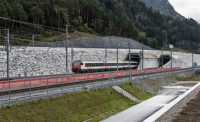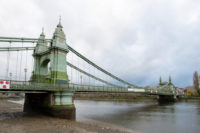U.S. and British researchers claim to have found a better explanation for the wobble of London's River Thames Millennium pedestrian suspension bridge than the one prevailing for over 20 years. Alarming swaying of the bridge was caused not by synchronization of walkers' footsteps, as previously believed, but the negative damping effect of their efforts not to fall over.
The conclusion "should enable bridge designers and other structural engineers to develop more accurate design criteria to avoid human-induced instability of a wide range of structures," reports the team, led by engineers and mathematicians from Georgia State University and the U.K.'s University of Bristol.
The research does not provide a "magic formula" for designers, but a means of estimating the level of damping needed to avoid excessive movements, it adds.
The three-span, 333-meter-long bridge was shut down three days after its June 2000 inauguration when swaying alarmed thousands of walkers. Engineers at the project's design firm Arup Group later reported sideways movement amplitudes of up to 7 cm at 0.95 cycles/second.
The firm attributed the movement to the tendency of a crowd of pedestrians to fall into step, setting up oscillations. Laboratory and live trials by the designers revealed that sideways displacements jumped dramatically at a critical loading, rather than rising steadily with increasing numbers of walkers.
But based on examination of nearly 30 bridges, the new report concludes that the synchronization of walkers is "a consequence, rather than a cause, of the instability". Instead, bridge motions cause walkers to adjust their pace, inducing "small quasiperiodic forces which have a component at the bridge frequency".
Such uncorrelated actions "produce negative lateral damping...to initiate significant bridge vibration, over a range of bridge natural frequencies," it adds.
Designed with the architect Foster and Partners, the bridge's slenderness resulted in "natural frequencies similar to typical pedestrian stride frequencies, while its relatively low mass also made it susceptible to significant vibrations," adds the report.
To support the aluminum deck, steelwork arms, set at 8-m intervals, project from either side and are suspended by stressed cables passing over two river piers and anchored at the abutments. The cables are roughly at deck level and sag 2.3-m over the 144-m main.
But “it wasn’t the form of the London Millennium Bridge that caused the problem," according to John Macdonald, a professor at Bristol's civil engineering department. "These large oscillations can occur on virtually any long bridge when carrying a sufficiently large crowd".
“It turns out that the forces from many random left and right footsteps do not cancel out, but positive feedback leads to the vibrations getting out of hand," he added.
Arup's solution was to add nearly 40 piston-like dampers, up to 16 m long, at various key points along the structure at a cost of several million dollars. It confirmed their effectiveness by getting around 2,000 people to make monitored crossings in January 2002.
The bridge reopened in February 2002 to become a major London landmark linking St. Paul's cathedral with the Tate Modern art gallery.





Post a comment to this article
Report Abusive Comment